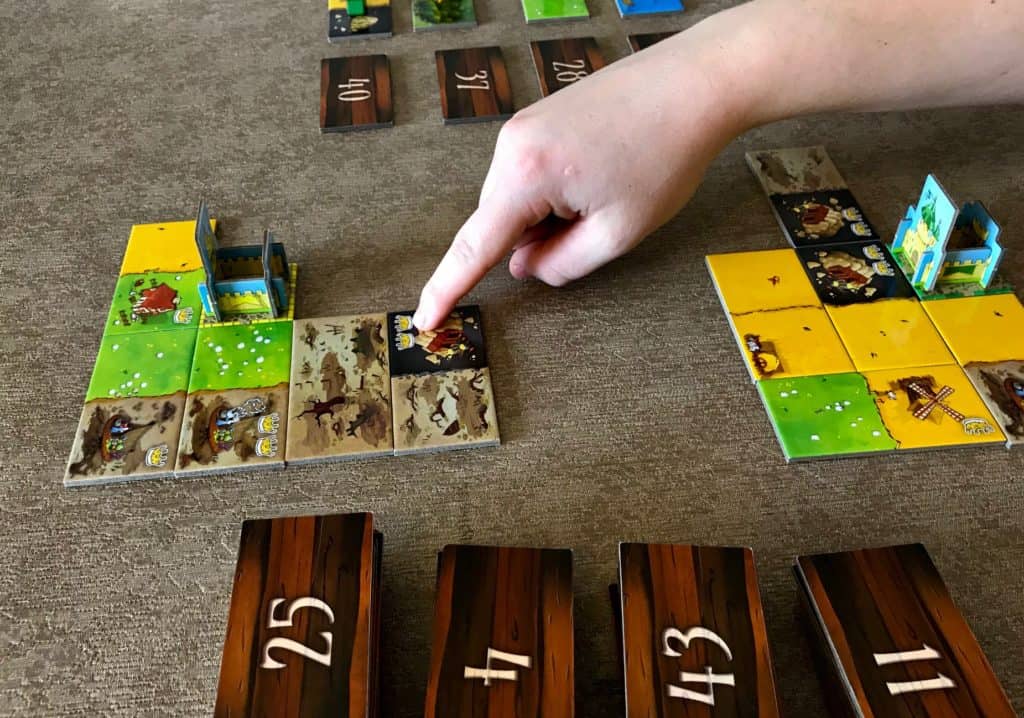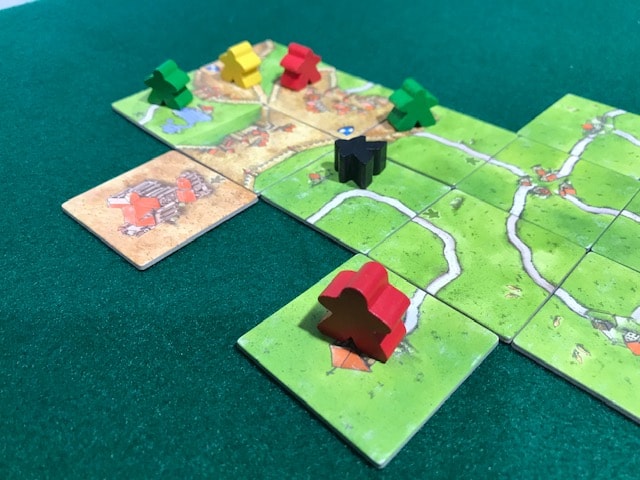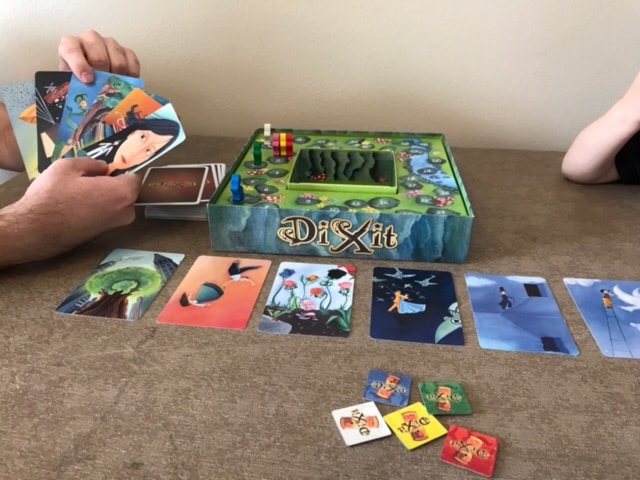A lot of what keeps people from playing games is that they have too many rules and they seem too complicated. Another stumbling block is that they just aren’t fun. Put those together and you really have some problems. So finding a perfect middle ground, for the many people who only like to play games that are simple, can be challenging. As someone that plays lots of games, I figured it would be useful to compile a list of games that are easy enough that they can be explained while playing—but are still fun.
9 board games that can be explained while playing
- Kingdomino
- Just One
- Carcassonne
- Bananagrams
- Codenames
- Big Money
- Dixit
- Chameleon
- Wits and Wagers
Admittedly, a few of these games don’t technically count as board games according to our definition, but we use the terms tabletop game and board game interchangeably in most circumstances. So let’s see why these games make the list.
1) Kingdomino

Specifics
| Players | Duration | Age | Type | Purchase At |
| 2-4 | 20-30 minutes | 8+ | Tile Laying | Amazon |
How does it play
Kingdomino might be the most complicated game on the list, so let’s get it out of the way first. But it still made the list, which means we can still explain it while playing. Kingdomino is a pastoral-themed game in which players attempt to gain the most points through collecting matching terrain tiles. Each round, 4 tiles are placed in order from least valuable to most valuable. The player that obtained the least valuable tile on the last round has first choice from the four tiles the next round.
Once players have obtained their tiles, a new set is turned over as players place the tiles on their growing board. Once completed the boards all must be a 5×5 grid and points are totalled. The number of same terrain tiles touching, multiplied by the number of crowns of that terrain type totals each player’s score.
Most difficult element
The most difficult part of this game to learn, is the scoring. Players often get confused about how many points they should get for each terrain. The main thing to remember here is that players multiply the crowns on the terrain tiles by the number of tiles touching of the same terrain. For example, if a player has 5 forest terrain tiles touching and two of those tiles have crowns, they would score 10 points. Any other forrest terrain tiles that player has would be counted separately—as its own group.
2) Just One
Specifics
| Players | Duration | Age | Type | Purchase At |
| 3-7+ | 20-30 minutes | 8+ | Cooperative | Amazon, Walmart online |
How does it play?
Just One is a cooperative, light-spirited game where players take turns guessing a word based on the clues the other players give. The word a player must guess, as well as the clues the others give, must only be one word each. Players write their clues on mini white boards they each possess, then compare them to the other clue givers.
If there are any players that wrote the same clues, those are eliminated. Only the unique clues are kept; the guessing player must determine what the word is by the remaining clues. The game ends after 13 words have been guessed. Players can check the team’s score against the rule book to see how they did when compared to averages of others who have played the game.
Most difficult element
There really aren’t any difficult parts to learn in Just One. If we were to choose one, it would be understanding which types of clues aren’t allowed. One major restricted clue is writing the word that is being guessed but writing it in another language. An example would be if the word was water and a clue giver wrote “agua”. It’s the exact same word, just written in a different language. Another clue that isn’t allowed is a variation of the same word. For example is the word being used is prince, a clue giver couldn’t write princess. Other than that, the game is extremely simple and fund to play!
3) Carcassonne

Specifics
| Players | Duration | Age | Type | Purchase At |
| 2-5 | 30-45 minutes | 8+ | Tile Laying | Amazon, Walmart Online |
How does it play?
Carcassonne is one of the best games on the planet! I have played it more than any other game I own. It is a game where players are competing to earn points by building castles, roads and fields. Each player takes turns laying tiles and placing meeples to claim certain areas on the map. Players that have control of certain areas can lose control as others creatively place more meeples in that area. Some points are earned as the game plays, while others aren’t totalled until the end, after control of the area is determined.
Most difficult element
The most difficult thing to learn in Carcassonne is how the point totalling in the fields is determined. Players lay meeples in the fields next to castles to earn 3 points per castle in the field. The problem is the fields combine during gameplay as players attempt to gain control of the fields. Additionally, players are building roads that twist and turn all over the board.
New players often have a difficult time recognizing where one field ends and where another field begins. The easiest way to teach this part is to play without fields on the first round; when the board is completed at the end, players can explain the fields to others.
4) Bananagrams
Specifics
| Players | Duration | Age | Type | Purchase At |
| 2-8+ | 15-20 minutes | 7+ | Word, Tile Placement | Walmart, Target, Amazon |
How does it play?
Bananagrams is a game I avoided playing for years, only to realize that I love it. It is a word-based game made up of dozens of little tiles, each with an individual letter on it. Players take 11-21 tiles (depending on the number of players) and begin to connect them to make words. As soon as one player connects all the letters into a web of connected words, he/she says “peel”; which means that all players must take a tile from the middle to add to their web of words.
As soon as that tile is worked in with all the other letters (by any player), the process repeats until there aren’t enough letters for each player to take another. The first player to make connected words out of all their tiles wins.
Most difficult element
The most difficult part about Bananagrams really comes in gameplay. There aren’t any difficult rules to learn or things to remember. Because players must connect all of their words together to win, the hardest part is finding words that are big enough to facilitate that effort. If they can manage that, the rest of the game is just fun.
5) Codenames
Specifics
| Players | Duration | Age | Type | Purchase At |
| 2-8+ | 15-20 minutes | 14+ | Word, party, deduction | Walmart, Target Amazon |
How does it play?
Codenames is an awesome party game where players are split into two teams. Each team designates a clue giver. 25 cards are laid out in a 5×5 grid and each card has a random word on it. The clue givers on each team have a secret card that assigns several words to each team. The clue giver must give one-word clues to their respective teams to get them to guess their words.
The more words each clue giver can link together with the clue, the faster the team can guess all the words—which is important because the first team to correctly guess all their words wins. But teams should look out, there is one restricted word. If players choose that word accidentally, they automatically lose. Additionally, a bad clue might lead a team to choose a word that belongs to the other team. If this happens, it puts the other team ahead.
Most difficult element
The hardest part to explain to new players is how to be a clue giver. Specifically, players must be able to look at the word-key card and know which cards are their team’s and which aren’t. The clues they will give are directly connected to the words they must get their team to guess. If they don’t understand how to find which are theirs and which aren’t they can’t be successful. It’s not too hard to learn, but it is definitely the hardest part of the game. Obviously, the easiest way to solve this is to have new players be guessers and not clue givers. Once they have the game down, they can give clues.
6) Big Money
Specifics
| Players | Duration | Age | Type | Purchase At |
| 2-5 | 30-40 minutes | 8+ | Dice, Card | Walmart, Amazon |
How does it play?
Big Money is a game where people make investments and everyone gets rich (Must be why I like it so much!). Players take turns rolling dice and buying investment cards. They can earn money through favorable dice rolls (that element plays a lot like Yahtzee); they can also earn money after buying investment cards. The investment cards interact with one of the die being rolled. If they own an investment in the industry that was rolled, they also collect money. They need to look out though; if a “Biz News” card is rolled, they have the possibility of losing some or all of their investments. Player with the most Zillions of dollars at the end of the game wins.
Most difficult element
The most difficult part of the game is learning how to determine how much money to collect on each roll. Investments cards interact with one another and certain dice rolls (like a full house) collect more than others. There is a key at the top of the game board for each of these rules and they are easy to follow. It doesn’t take much time to find, but there are quite a few possible combinations, so remembering them is hard.
7) Dixit

Specifics
| Players | Duration | Age | Type | Purchase At |
| 3-6 | 30-45 minutes | 8+ | Card, Party | Walmart, Amazon |
How does it play?
Dixit is a game made up mostly of obscure picture cards where each player always holds 6 of those cards. Each round a lead player says a word, phrase or pretty much anything else to the other players as a “clue”. Then, everyone (even the lead player) puts one of their picture cards in a pile face down that most closely matches that clue. The cards are shuffled and then laid out face up in a row. Each player then guesses which card is the lead player’s card. Players that get it right score points. Players that pull guesses away from the lead player’s card to their cards gain points. First to 30 points wins.
Most difficult element
Yet another game that just doesn’t really have any hard game mechanics. If there were a hard concept it would be understanding how to give a clue as the lead player. It must be specific enough that some players figure it out, and yet abstract enough that not all players choose it (if all players choose it, the lead player doesn’t score and everyone else does). It can be tricky to figure out just the right amount of each to get it right.
8) Chameleon
Specifics
| Players | Duration | Age | Type | Purchase At |
| 3-8 | 5-10 minutes | 14+ | Bluffing, Card | Target, Walmart, Amazon |
How does it play?
Chameleon has got to be the quickest game to play through on the list. If often takes less than 5 minutes to get through a round, though it can take a lot longer than that too. At the beginning of a round, players roll a set of dice which determine what topic players will use. All players, except for one, learn what that topic is and then come up with “clues” that they will take turns saying to the group.
The clues must be crafted so that they 1) relate to the chosen topic and indicate to the other players that they are not the chameleon and 2) don’t give the word away to the chameleon. The chameleon’s goal is to ensure their clue blends in even though he/she doesn’t know the topic. Everyone else’s goal is to find the chameleon. After the clues are given, everyone talks and then votes on who they think the chameleon is. If they find the chameleon, they win; if they vote on someone else, the chameleon wins.
Most difficult element
The only somewhat difficult part to learning this game is finding the right topic that players are using this round. After a dice roll, players look on a grid of potential topics and must find the one being used. I’ve played several rounds where a player wasn’t the chameleon but gave clues that were way off topic. It was quickly apparent that they were either the chameleon or they misread which topic was being used. As with the other games, this isn’t hard to learn, but can be messed up if not paying close attention. Other than that, it’s a very simple, fun party game.
9) Wits and Wagers
Specifics
| Players | Duration | Age | Type | Purchase At |
| 3-7 | 30-45 minutes | 10+ | Party, Trivia | Walmart, Target, Amazon |
How does it play?
Wits and Wagers is the most fun trivia game I’ve ever played. It’s been out for a long time now, yet I still find people all the time that have never played. The purpose is to make the most money through betting on random trivia facts over 7 rounds. At the beginning of each round, a player reads a trivia question that no one actually knows the answer to. Players write their guesses on small dry-erase boards, which then go in the middle. The guesses are lined up from smallest to largest and players bet on which they think is closest. At the end of the rounds, the player to have to most money wins.
Most difficult element
There is no complexity to this game and therefore no rules that are hard to learn. The hardest thing about this game is finding dry-erase markers that still work! If you can find those, it’s smooth sailing through the game. This is one of the easiest games to learn as you play. If you can come up with an answer—even a really bad one—to the trivia questions, then you can understand this game.
Conclusion
Obviously, as always, there are more games than this that could be explained while playing, but these are the ones we really think are the best in this category. Feel free to check out our resources page, that can be accessed by clicking this link, or by using the menu bar. We keep our top recommendations there at all times! you can’t go wrong with any of those.
